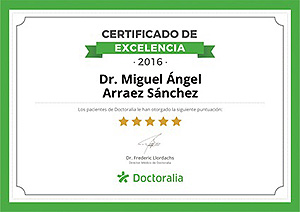Tumours of the Nervous System
Tumours of the central nervous system in the brain, spinal cord and skull base.

Brain tumours comprise a wide and heterogeneous range of illnesses affecting the brain and its relating structures. There is a great variety from curable, benign tumours with no major complications, to extremely aggressive and malignant processes which are difficult to treat and produce important sequels and high mortality.
The Most Common Brain Tumours
There is a wide range of brain tumours, depending on the genesis of the different types of cells found in and around the brain. Accordingly, there are tumours of the same cells which form the brain and its nerves:
• Gliomas (the most common type of tumour, ‘primary’)
• Neurocytoma
• Schwannoma or Neurilemmoma
• Tumours in the membranes that cover the brain or meninges (meningioma)
• Bone tumours
• Cysts or pseudo tumours
• Pituitary tumours
• Embryonic and primitive tumours
• Tumours associated with blood vessels etc.
Another important group are cerebral metastasis or ‘secondary’ tumours, which have travelled from another organ with a primary tumour or cancer and have spread to the brain, where they grow again as a tumour.
What are the Most Common Symptoms?
The symptoms are the product of two situations:
- The increase in generalised pressure of the encephalon (intracranial hypertension)
- A deficit produced by the mass and alteration in the function of the neurons around the area affected by the tumour (focal deficit)
The general increase in pressure produces headache, vomiting and partial loss of consciousness among other effects. The focal deficit depends on the location of the tumour and the effect of the mass on the surrounding areas. Accordingly, there may be alterations in the motor function of the limbs, sensitivity, vision, coordination or language etc. Patients may also have seizures (epilepsy) in some cases.
How are these tumours diagnosed?
When the presence of a tumour of this type is suspected, neuro-image examinations are essential for diagnosis (CT, MRI or other scans). The examinations allow us to locate the tumour, as well as giving us some details about structure allowing us to understand the nature of the lesion (benign or malignant, primary or secondary, single or multiple). A definitive histological diagnosis is finally given in the study of the biopsy of the lesion, which is obtained through a neuro-surgical procedure, specific to each patient.
What is the treatment?
There are many different therapies for these lesions, and the most appropriate should be chosen for each particular tumour and specific patient. In some cases, a neuro-surgical procedure should be carried out using microsurgical techniques for tumor removal or just to obtain a sample in order to know what kind of tumour it is.. In some cases only a biopsy of the tumour will be carried out (such as tumours located in very delicate areas, or patients not in general condition for long and complex surgery). This can be performed using stereotactic techniques, targeting the exact point of the lesion with an external frame and allowing a small sample of the tumour to be taken with great precision. Depending on the result of the tumour biopsy and the degree of resection treatment may be complemented in some cases using radiotherapy, radiosurgery and/or chemotherapy.
What is the Prognosis and Possible Sequelae for This Illness?
It isn’t possible to give a prognosis for all brain tumours since each one is very different. Some of these tumours have very good prognosis with no further sequelae (such as the majority of convexity meningiomas) while others have worse prognosis in spite of any treatment carried out (such as high-grade gliomas or glioblastomas). It is important to point out that ‘benign’ tumours, such as schwannomas (which are not cancerous) can be located in very difficult places within the encephalon, which can also worsen the prognosis and possible sequels.
Who are the Specialists Who Treat These Lesions?
The neurosurgeon has to play the initial role in the management of the aforementioned conditions with a surgical operation for resection or biopsy. Micro-neurosurgery, stereotactic surgery, radiotherapy, radiosurgery, intervention neuro-radiology and chemotherapy come together to improve the prognoses of brain tumour lesions in a speciality known as neuro-oncology. We work under this multidisciplinary concept for all required treatments to obtain the best possible result. Thus, neurosurgeons, neurologists, radiotherapists, oncologists, radiologists and nuclear medicine specialists among others are brought together in this team and work in synergy.
Pituitary Tumors
These are relatively common tumours which come from the pituitary gland at the base of the skull and which carry out vital functions. They are usually benign tumours but they can be a challenge for neursurgeons due to their location.
What are the Symptoms of Pituitary Tumors?
The symptoms vary greatly and depend on the size of the tumour and the hormones it may produce or abolish:
- The primary symptom in many cases is deterioration of vision, which usually consists in a visual field defect (the area of vision towards the sides of both eyes) as they compress the optic tracts in the optic chiasm (where both optic nerves meet). This symptom may not be detected until a very advanced stage in large tumours.
- Symptoms derived from increase in the circulation of certain hormones. A very common one is Prolactinoma which produces increase in prolactine hormone. This increase in prolactin may be due to a tumour which produces the hormone (prolactinoma) or a tumour which compresses and increases prolactin in this way. The symptoms are related to alterations in the woman’s menstrual cycle or infertility in women for example lactating at times when you shouldn’t. Other hormones which may increase are growth hormones (which causes giantism or acromegalia) and cortisol (Cushing disease). These are the primary hormones, although others may also be increased.
- The following symptoms may be observed when the tumour is quite large: headache, dizziness, visual loss, fainting and other less specific symptoms.
Some patients start with severe symptoms of pituitary apoplexy which occurs when a tumour does not have enough blood supply resulting in necrosis and/or bleeding. In these cases it may result in severe headache, quick and severe deterioration of vision, partial or total loss of consciousness, coma or even death. These are symptoms of a medical emergency and those conditions are indication for surgical operation.
How Can you Diagnose a Pituitary Tumour?
When a pituitary lesion is suspected according to the symptoms we have described, examining images of the brain and skull base allows us to clearly define the location and size of the lesion as well as other relevant characteristics. This may be through scan of the brain and sella turcica or an MRI scan. Sometimes it is necessary to carry out other examinations, such as a conventional cerebral angiogram or by resonance or scanner in order to rule out vascular lesions (such as brain aneurisms) which can simulate a pituitary tumour. Nowadays, magnetic resonance is the examination which provides the most information. Alongside these examinations of the images, a hormone study should be carried out to determine if the tumour produces any hormones. As previously mentioned, in many cases of non-functioning tumours there is an increase in the levels of prolactin (the hormone secreted through adenohypophysis) due to the compression of the tumour and not the increase in the cells produced. When we are in the presence of a tumour which truly produces a hormone, it may be treated with medicine and not always with surgery, which is why the hormone study is so important prior to surgery.
How Are These Tumours Operated on?
In most cases these tumours are accessed through access known as ‘transsphenoidal’ approach due to the need to pass through this bone (known as the sphenoid) at the base of the skull. This procedure then passes through to the bottom of the sella turcica containing the hypophysis. This operation is carried out through the nose. The tumour is accessed from the base, and the resection is carried out on the tumor capsule (a name used for didactic purposes) as widely as possible.
When, due to the nature of the tumour, an adequate transsphenoidal resection is not possible it is necessary to access the tumour directly through the cranium, usually allowing a wider resection of the lesion. This method is reserved for cases in which transsphenoidal is not considered optimal which only occurs in a minority of patients.




